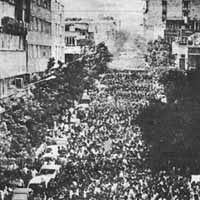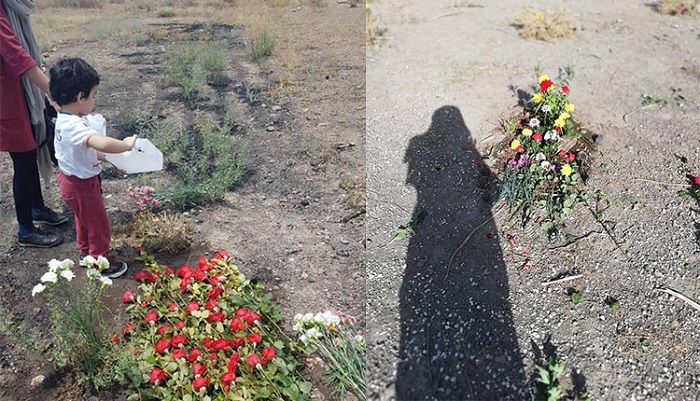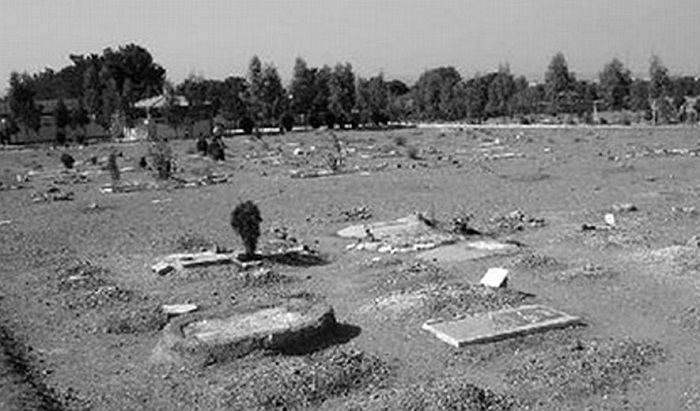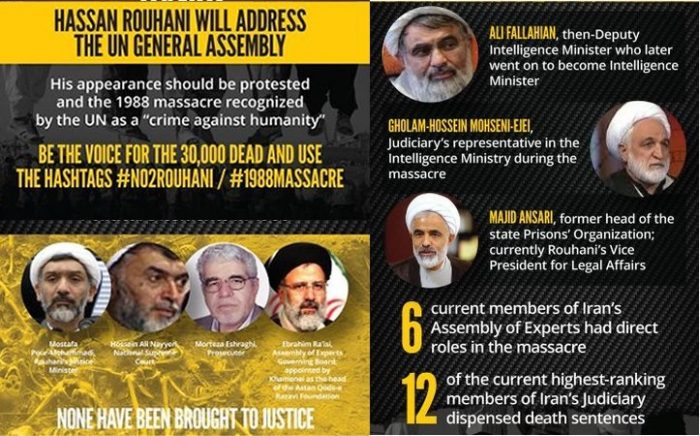
A monument on the 1988 massacre of the 30,000 political prisoners (mainly MEK members and supporters)
The Iranian regime has a long and brutal history of violently suppressing any individual or group that does not align with its rigid beliefs or who dares to speak in dissent. Protesters, religious minorities, journalists, and trade unionists are all frequent targets of the regime’s wrath, with the Peoples Mojahedin Organization of Iran (PMOI / MEK) suffering the largest number of casualties at the hands of the clerical dictatorship.
Iran Human Rights Monitor (Iran HRM) released a report on Thursday detailing forced disappearances of political prisoners mainly MEK members and supporters in Iran during the 1980s and the regime’s continued persecution of the family members who seek justice for their family members who were disappeared in the 1980s or executed during the 1988 Massacre.
Enforced Disappearances

More than a half-million MEK supporters attended a rally in Tehran on June 20, 1981, to protest against the mullahs’ encroaching totalitarian policies and support freedom and democracy.
After the regime violently suppressed peaceful demonstrations on June 20, 1981, and firmly established its authoritarian rule, it shifted its crackdown to the MEK. This crackdown reached its climax during the 1988 Massacre 30,000 political prisoners, according to the Iran HRM report.
Over the course of a single summer, 30,000 political prisoners, most of whom were members of the MEK, were taken before extra-judicial death commissions and sentenced to execution in trials that lasted only minutes. Many of the victims, who included pregnant women and teenagers, had already completed their sentences but had not been released.
Outside of the regime’s prisons, widespread enforced disappearances were taking place at the same time. Former political prisoners and MEK supporters disappeared and were executed in secret.
According to the Iran HRM report, the victims were hanged by forklifts and cranes or from beams in partially-constructed buildings. Some were executed by firing squads. In order to expedite the murders, people were killed in groups of five or six in 30-minute intervals throughout the day.
International law states that the crime of enforced disappearance continues until the state reveals the fate or location of the individual concerned. If the disappeared individual is determined to be dead, the remains must be returned to their family. By this definition, the victims of the 1988 Massacre also count as victims of enforced disappearances under international law.
Mass Graves
The sheer number of victims made individual burial impossible, so the regime simply dumped the bodies into mass graves. There are an estimated 120 mass grave sites containing remains of victims of the 1988 Massacre and enforced disappearances, according to Iran HRM.

The number of victims made individual burial impossible, so the regime simply dumped the bodies into mass graves
According to Amnesty International, the Iranian regime did not return any of the bodies of the victims of the 1988 Massacre to their families. They also did not disclose the location of the burial sites to most families, in an attempt to conceal their crimes. Some families were given a plastic bag containing the victim’s possessions, along with an order to never publicly mourn them. Few MEK families ever received death certificates.
Amnesty International reported that authorities in only five cities eventually told family members verbally that their loved ones were buried in mass graves and disclosed the locations. These officials now deny any knowledge of these graves or any other, despite satellite evidence to the contrary.
Officials in a handful of other cities gave family members the locations of individual graves and allowed them to construct headstones, but Amnesty International found that most of these graves aren’t in the cemetery’s online registry, prompting fears that the graves are empty. Several reports say that the gravestones were installed suddenly in 1988 or 1989 without prior digging, leading many to believe that officials lied to families to minimize the number of deaths from the 1988 Massacre. In 2017, one family did discover that the grave they were told their loved one rested in was empty, according to Amnesty.
Iran HRM noted that the Iranian regime has taken extreme measures to destroy all evidence of these mass graves. They have bulldozed the sites and built new cemeteries on top of them, paved over them, and constructed buildings and roads on top of the graves of their victims.

Khavaran- A site of a mass grave for some of the MEK members and supporters that were executed during the 1988 massacre of political prisoners in Iran
Family members of MEK who have attempted to find their loved ones’ graves have been arrested and tortured, according to Iran HRM.
Families cannot legally inquire about their relatives inside Iran.
None of the perpetrators of the 1988 Massacre have ever faced justice for their roles in this crime against humanity. Many have gone on to hold high-ranking positions within the regime. Amnesty International considers “the agonizing suffering inflicted on victims’ families for more than 30 years” is a violation of “the absolute prohibition on torture and other cruel and inhuman treatment under international law.”
Ali Saremi
MEK supporter Ali Saremi was executed by regime authorities in 2011 for his peaceful activism on behalf of the victims of the 1988 Massacre and the enforced disappearances in Iran. Serena served a total of 23 years in prison for his activism. He was arrested in 2007 for delivering a speech at Khavaran Cemetery outside Tehran, calling for justice for the victims buried in mass unmarked graves on that site, and sentenced to death.
Maryam Akbari-Monfared
Political prisoner Maryam Akbari-Monfared lost three brothers and a sister in the 1980s under regime rule. Her siblings, Roghieh and Abdolreza, were executed during the 1988 Massacre, and while the regime verbally informed Akbari-Monfared’s parents of their executions, it has never revealed where they are buried.
In February 2017, Ms. Akbari-Monfared asked the U.N. for help in finding her siblings. Because their burial locations were never disclosed, the U.N. Working Group on Involuntary and Enforced Disappearances (WGEID) has recognized the two victims as enforced disappeared persons.
Mansoureh Behkish lost six siblings during the #1988Massacre. She is one of those targeted for their peaceful activities inquiring about the truth & seeking justice.#NoImpunity4Mullahs #EnforcedDisappearance #WGEID @AgnesCallamerd @FranceONU @USAdarFarsihttps://t.co/S13b0JNsqm pic.twitter.com/y9hhODiNmz
— Iran Freedom (@4FreedominIran) August 30, 2019
Mansoureh Behkish
Mansoureh Behkish is one of the many family members of victims of the 1988 Massacre who have been targeted by the regime for seeking justice. After losing six siblings in the 1988 Massacre, she has faced persecution by the regime for a number of peaceful activities, including holding memorial services at her home for political prisoners who were executed or forcibly disappeared during the 1980s, including her sister, four brothers and a brother-in-law; visiting the families of victims; taking flowers to the site of the unmarked mass graves in Khavaran where two of her brothers are buried; and posting about the Iranian regime’s human rights violations on Facebook and other online platforms.
Raheleh Rahemipour
The regime prosecuted Raheleh Rahemipour and sentenced her to two years in prison as retaliation for filing a complaint with the United Nations. The 65-year-old human rights activist reported the forced disappearance of her brother and infant daughter during their detention in Evin in Tehran between 1983 and 1984.
Human rights defender Raheleh Rahemipour arrested in Iran #FreeOurDefenders https://t.co/n2h8E0m2QE pic.twitter.com/sIUiEqylJi
— Amnesty Iran (@AmnestyIran) September 11, 2017
Ministry of Intelligence and Security (MOIS) officials informed Ms. Rahemipour would let her go free if she withdrew her complaint from the U.N.
Acts of Impunity

high ranking officials of the Iranian regime who are responsible for crimes against humanity, and were members of the “Death Committee” during the 1988 massacre of MEK supporters, but enjoy impunity and have actually been promoted to higher positions within the mullah’s ranks.
The regime has never had to answer for its crimes against humanity, so its human rights violations continue unabated. Without fear of consequences, regime leaders have no qualms about elevating war criminals to positions of power. Former Death Commissioner Ebrahim Raisi is now the regime’s Judiciary Chief. Former Death Commissioner Mostafa Pour Mohammadi, who is now an advisor to Raisi, recently publicly defended the 1988 Massacre and further vowed to “eliminate the MEK.”
Continued Enforced Disappearances
Enforced disappearances still happen under the mullahs’ rule, and they will continue until the regime is held accountable for its crimes.
Kurdish Political Prisoners
Shirin Alam Holi, Farzad Kamangar, Ali Heidarian, and Farhad Vakili were executed by the regime in 2010. Their bodies were never returned to their families, and their places of burial have not been disclosed. The UN Working Group on Enforced or Involuntary Disappearances recently recognized all four of these cases as enforced disappearances and as such, has asked regime officials to submit documentation of the victims’ fates and locations.
The UN WGEI has recently recognized the cases of Kurdish political prisoners Shirin Alam Holi, Farzad Kamangar, Ali Heidarian & Farhad Vakili executed in 2010, as #EnforcedDisappearances since their bodies were never turned in to their families #Iran pic.twitter.com/W70bBwbqWY
— IRAN HRM (@IranHrm) August 29, 2019
Zanyar Moradi, Loghman Moradi, and Ramin Hossein Panah were executed on September 8, 2018. The executions took place despite widespread condemnation from the international community and months of protests by human rights organizations. Regime authorities refused to release the victims’ bodies to their families for burial.
University Student Protester
Saeed Zeinali was arrested on July 10, 1999, five days after widespread student protests took place across Iran. Zeinali, who was a 22-year-old Computer Science Major at Tehran University at the time of his arrest, has not been seen or heard from since a brief phone call three months after his arrest. Regime officials deny that any knowledge of his arrest.
An Ongoing Nightmare
For the families of the victims of the 1988 Massacre, the crime is far from over. “The families of those secretly killed in the 1988 prison massacres are still living through a nightmare. They and many others in Iran are haunted by the thousands of missing bodies, which have cast a specter over the country’s justice system to this day,” said Philip Luther, Middle East, and North Africa Research and Advocacy Director at Amnesty International.
“It is misguided to view the 1988 mass killings as historical events. The enforced disappearances are ongoing and, 30 years later, victims’ families continue to be tormented by anguish and uncertainty over the fate of their loved ones,” he added.
A Call to Action
The MEK and the Iranian Resistance urge the international community, the U.N. Security Council, the U.N. Human Rights Council and its member states, all other relevant United Nations agencies, the European Union, and all advocates of human rights and justice to end impunity for the perpetrators of the 1988 massacre.
The international community, particularly the U.N., Is obligated to hold Iran responsible for its role in this crime. The Iranian regime will continue to flagrantly violate human rights laws as long as it knows it can act without consequences.
The U.N. must refer to the dossier of human rights violations in Iran, particularly the enforced disappearances of the 1980s and the 1988 Massacre, to the U.N. Security Council.
The Unpunished Crime #1988massacre of political prisoners in #Iran https://t.co/8NJ39qf8X4#IranWomen#HUmanrights
— Women's Committee NCRI (@womenncri) August 29, 2019
The MEK urges the U.N. to conduct an independent investigation into the fates of the victims of forced disappearances during the 1988 Massacre.
“Crimes against humanity are exactly what the term suggests: crimes so serious that they concern not only their victims, survivors and the state in question but also humanity as a whole,” stated Amnesty International’sPhilip Luther, in calling for an international investigation into the 1988 Massacre.
“U.N. member states must use every opportunity, including the upcoming review of Iran’s human rights record at the U.N. Human Rights Council in November, to press the Iranian government to identify mass graves and reveal the fate and whereabouts of all victims of these tragic events,” he added.
Staff Writer
